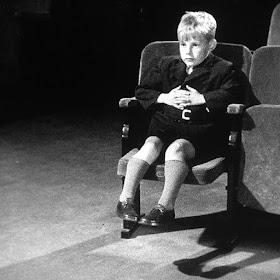Three stories — presented as flashbacks and nested flashbacks — spun by a group of wives awaiting their husbands' arrival at the country house in which they're taking holiday: the peculiarly titled (at least in English) Women's Waiting [Kvinnors väntan, 1952], often translated as Waiting Women and once upon a somewhere released as Story of Women, based on a story by Gun Grut. (By 1952, Bergman's days of working from adaptations are numbered.)
(1) Rakel (Anita Björk), Eugen (Karl-Arne Holmsten), and Kaj (Jari Kulle).
(2) Marta (Maj-Britt Nilsson, who checks out her figure with satisfaction after leaving the gynecologist in Paris), the neighbor Martin (Birger Malmsten), whose older brother Fredrik is played by Gunnar Björnstrand in what I believe constitutes his premiere appearance in Bergman.
(3) Karin (Eva Dahlbeck) and Fredrik, trapped in a malfunctioning elevator, and forced by circumstances into intimate talk.
Fernanda Solórzano writes in her essay "In the Company of Women" (translated from the Spanish by Deborah Wassertzug) included in Criterion's Ingmar Bergman's Cinema: "To pass the time, each [wife] tells the others about a marital episode that revealed to her something about her husband and the nature of their relationship. [...] The conversations between [the women] reveal that they have considered the positive and negative aspects of their marriages — and decided to remain in them." That there's even the consideration of an option distinguishes the Swedish cinema of '52 from any American production of the same era. In the same volume, Bergman has the following to say, taken from a 1964 interview with Playboy: "Women used to interest me as subjects because they were so ridiculously treated and shown in movies. I simply showed them as they actually are — or at least closer to what they are than the silly representations of them in the movies of the thirties and forties. Any reasonably realistic treatment looked great by comparison with what was being done." •
Kris [Crisis, 1946]
Skepp till India Land [Ship to India, 1947]
Hamnstad [Port of Call, 1948]
Törst [Thirst, 1949]
Till glädje [To Joy, 1950]
Sommarlek [Summer Interlude, 1951]
Kvinnors väntan [Women's Waiting, 1952]

























































